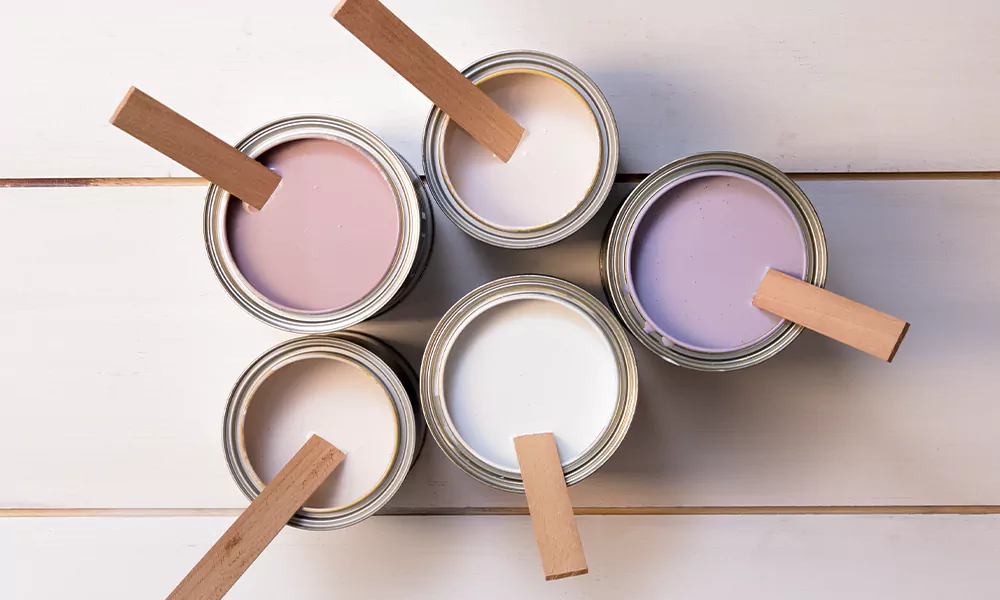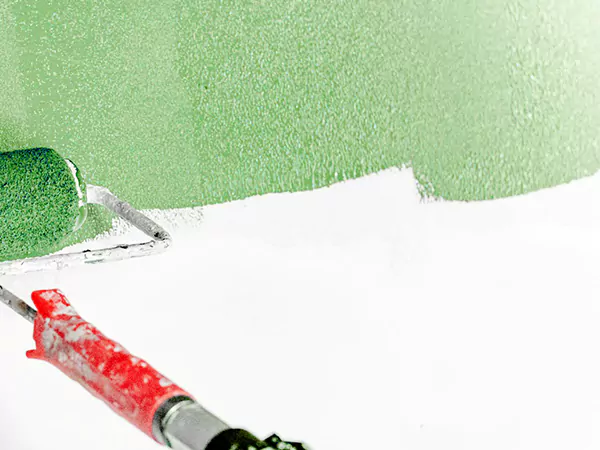Article Chapters
Waterborne paints are able to combine artistry and sustainability in the paint world to offer creative colors. Unlike solvent-based paints, waterborne paints use water as a solvent, making them a champion of the environment and a guardian of indoor air quality. Follow me into the world of waterborne paints and learn about the types of waterborne paints, tips for choosing the right paint, and comparisons with oil-based paints to help you understand and choose the right paint for your needs.
What is water based paint?
Water-based paints include emulsion paints and water-based paints. Water-based paints are the “water rangers” in the paint world. Traditional paints rely on chemical solvents, while water-based paints use water as the main solvent, making them the heroes of environmentally friendly home decoration. In addition to water, water-based paints also include pigments, binders, and additives. Binders act as glue to bind the paint together and form a durable paint film after drying. Additives are the unsung heroes in paint formulas, giving paints special properties such as enhanced fluidity, extended working time, and protection against damage such as mold and moisture. When the water evaporates, water-based paints leave a “cured” film on the surface of the object and no longer dissolve in water.
This paint gets rid of the pungent smell of oil-based paints and brings fresh air with its mild scent. This is not only a choice, but also reflects the constructor’s love for the earth. It has won the hearts of all users who seek to combine functionality with environmental awareness. Click here to read application guidelines for applying, thinning, and cleaning waterborne coatings.
Advantages of water-based paint:
It has the following product advantages:
- Green and environmentally friendly – odorless or less odor. Contains fewer volatile organic compounds (VOCs) and is safe for children.
- No smoke – When applied, water-based coatings do not produce toxic fumes like oil-based coatings used in industry. Therefore no gas mask is required.
- Durability – Excellent adhesion to most substrates. And it has better flexibility than oil-based paint and is not easy to yellow or crack.
- Easy to apply – smooth and even application with less brush resistance.
- Versatility – Can be used on a variety of substrates including wood, concrete, stucco, brick, aluminum siding, vinyl siding and galvanized metal.
- Short drying time – it dries within one to six hours at room temperature and can be applied quickly for the second time.
- Easy to clean – Easily cleans up with water and soap.
Disadvantages of water-based paint:
Although water-based paints have many advantages, sometimes we prefer to choose oil-based paints for several reasons, such as:
- Temperature Sensitive – Water-based coatings will become difficult to use when the temperature is below 50 degrees Fahrenheit.
- Marks – Water-based paints may show more paint marks and are not as smooth and flat as oil-based paints.
- Not suitable for smooth surfaces – Water-based coatings have poor adhesion on smooth surfaces.
- Not resistant to stains – Water-based paints are more susceptible to stains due to their low surface gloss.
- Water Sensitive – Water-based coatings are prone to blistering, mold and even falling off in humid and humid environments.

Realms of Application
From the hulls of ships that sail the seven seas to the humble walls of our homes, water-based paints coat a variety of surfaces. They’re the go-to for interior walls, where their low odor allows you to paint your bedroom today and dream in it tonight, and for exteriors, where their durability lets them stand guard against the elements like steadfast lighthouses.
The history of water-based coatings.
The tale of water-based paint stretches back to ancient times when early humans mixed pigments with water to tell their stories on cave walls. This age-old tradition has evolved, with water-based paints now encapsulating advanced technology and environmental awareness, continuing the legacy of those first artists with every stroke.Early “paints” were made from clay, berries, and different types of flowers. In the early days, binders included animal fats, milk, and even eggs.
It was not until 1865 that DP Flinn mixed water with liquids such as potassium hydroxide, zinc oxide, resin and linseed oil, and obtained the first patent for water-based coatings. Over the next few decades, manufacturers continued to improve the formulations of coating products based on this foundation.
Time comes to the 1940s. The introduction of latex revolutionized the coatings industry, allowing the production of higher quality water-based coatings. Worth noting: The “latex” used in coatings is a modern synthetic polymer with unique properties and properties. It is different from natural latex rubber.
So, as we embrace the future, let’s paint it bright with water-based paints, the guardians of the environment and the champions of color. They’re not just coatings; they’re the medium through which we can all leave a mark on the world, one brushstroke at a time.
What are the common types of water-based coatings?
At the heart of the versatility of water-based coatings lies their resin polymers—the secret sauce that determines everything from durability to finish. These resins, which include acrylics, latex, vinyl, alkyds, epoxies, fluoropolymers, polyesters, polyurethanes, silicones, and enamels, are the backbone of coatings and determine the application, performance, and aesthetic qualities of water-based coatings. Let’s start by looking at the two most common types of water-based coatings:
- Latex paint: It’s a household hero in wall coatings and is ultra-cost-effective. Latex paints are primarily composed of aqueous solutions of synthetic polymers and are known for their ease of application and environmental compatibility. It is a typical choice for interior walls and ceilings, offering excellent coverage, easy cleaning and a breathable finish. The breathability of latex paint allows moisture to escape from the wall, reducing the risk of mold. The only drawback is that it is not wear-resistant.
- Acrylic paint: Acrylics stand out for their exceptional durability and color retention, making acrylic water paint a top choice for artists and homeowners alike. This type of paint dries quickly, creating a waterproof layer that is both strong and vibrant. Its versatility makes it a favorite for everything from canvas to concrete, embodying the spirit of adaptability.
Typically, water-based paints that are clearly labeled “acrylic” contain more acrylic polymers than latex paints. But water-based paints with higher acrylic content also cost more.
Substance types of other water-based coatings:
- Vinyl and Alkyd Resinsenhance adhesion and durability, making them suitable for challenging surfaces and high-traffic areas.
- Epoxy Resinsprovide a hard, protective finish, ideal for floors and surfaces in industrial settings or areas with heavy wear.
- Fluoropolymersoffer unparalleled resistance to weathering and UV light, preserving the paint’s color and integrity in harsh outdoor environments.
- Polyester and Polyurethanebring robustness and flexibility, offering protective qualities along with aesthetic versatility for a wide range of design preferences.
- Silicone and Enamel Resinsare known for their heat resistance and glossy finish, thriving in environments where other paints might falter.
Each resin type within water-based paint serves a specific purpose, influencing not just the application and durability, but also the environmental impact of the paint. From the artist’s canvas to the exterior of a skyscraper, these resins allow water-based paints to cover our world in colors that are not only beautiful but also bear a lighter ecological footprint.
How to choose water based paint?
The process of selecting the perfect water-based paint can be like a kid in a candy store – all the brightly colored options and varieties at your fingertips are exciting but difficult to know which one to choose. Don’t worry, we’ll guide you through making the right choice to ensure your next painting project lives up to expectations.
- Understand your application scenario:
What you are preparing to paint and its surroundings play an important role in your decision-making process. Is it the large walls of the living room, the sun exposure of the exterior of the house, the well-maintained wood furniture or the rough floor of the garage? Each scenario requires a specific type of water-based coating to address the unique challenges it will face. Interior paint prioritizes ease of cleaning and resistance to wear and tear in daily life, while exterior paint focuses on weather resistance and resistance to weathering. For special surfaces, the fluidity of water-based coatings needs to be considered. - Types of resins contained in water-based coatings:
From the above we already know that the resin of water-based paint determines the durability, smoothness and overall performance of the paint. Although acrylics and latex dominate the world of water-based coatings due to their versatility and environmental friendliness. However, you can also choose water-based paints that contain other types of substances depending on your specific needs. - Cost conundrum:
Use water-based coatings that are easy to apply and offer increased durability. The initial cost of acquisition will be higher, but if you’re in the long term, it’s worth it. Generally, if you need more weather resistance, it’s recommended to choose water-based coatings with a higher acrylic content. - Environmental awareness:
In today’s increasingly eco-conscious world, choosing water-based paint is a stroke of environmental genius. With low levels of volatile organic compounds (VOCs) and odor, these paints not only decorate your walls but also pay homage to nature. - Brilliant colors:
Finally, let your creative flag fly when choosing a hue. Water-based paints come in a rainbow of colors, providing vibrant pigment that stays true over time. Whether you’re painting a statement wall or adding a subtle hue to a room, the color options are wide-ranging, vibrant, and largely dependent on your personal preferences.

Choosing the right water-based paint is a combination of artistic vision, practical considerations and environmental awareness. It’s about portraying a space that is your own, while ensuring it will stand the test of time and nature.
Oil based paints VS water based paints.
As we all know, Oil-based paints use oil as their solvent, while water-based paints use water instead. . Choosing oil-based coatings or water-based coatings will directly affect the quality and construction cycle of the paint project. The choice between them is as daunting as choosing between a dragon and a unicorn. Both have their own advantages and disadvantages. Correctly understanding the difference between oil-based paint and water-based paint can help you choose the right type of paint for your project.
- Element
Oil-based coatings: Oil-based coatings use an organic solvent (usually mineral turpentine, linseed oil, or other solvents) as a base to make them durable and resistant to wear and tear. However, these solvents also emit strong fumes that require harsh chemicals to clean up.
Water-based coatings: Water-based coatings, on the other hand, use (you guessed it) water as a base. They contain lower levels of volatile organic compounds (VOCs), are less harmful to the environment and are easier to clean up. - Gloss
Oil-based paints: Oil-based paints typically have a higher gloss level, giving them a shiny surface that can make colors appear more vibrant. While oil-based paint resists fading longer than water-based paint, it tends to yellow over time.
Water-based coatings: Water-based coatings are available in a variety of finishes, including matte, eggshell, satin and semi-gloss, providing more versatility in achieving different looks. Nonetheless, water-based paints have a duller shine than oil-based paints. But water-based paints are UV resistant, making it easier to maintain consistent color over time. - Drying time
Oil-based coatings: Oil-based coatings take longer to dry. Under the same environment, the drying time required for oil-based coatings is 4-5 times that of water-based coatings. More patience is required between coats of paint.
Water-based coatings: Water-based coatings dry faster, typically within 2-6 hours, allowing projects to be completed faster. - Durability and service life
Oil-based coatings: The drying oils in oil-based coatings create a hard surface when completely dry, making them more durable. Also, oil-based paint seals the surface very well. Therefore, they have better moisture resistance than water-based paints. However, the resulting oil-based finish is very brittle and will crack or turn white over time or under long-term UV exposure.
Water-based coatings: While water-based coatings may not be as durable as oil-based coatings, advances in technology have made them more resistant to wear and fading than ever before. - Environmental protection
Oil-based coatings: Oil-based coatings contain higher levels of volatile organic compounds, which can cause indoor air pollution and have a greater impact on the environment. And there are strict requirements for the storage environment.
Water-based coatings: Because their main ingredient is water, water-based coatings contain lower levels of volatile organic compounds, making them a more environmentally friendly option. - Ideal Applications
Oil-based paint: Oil-based paint is best for surfaces that require a high level of protection and durability, such as trim, cabinets, and furniture.
Water-based paint: Water-based paint is ideal for interior walls, ceilings and surfaces that need to dry quickly and be easy to clean. - Weather conditions
Oil-based coatings: Oil-based coatings are more tolerant to different weather conditions during construction, so extreme temperatures and humidity environments will not have a big impact on construction, drying time and coating performance.
Water-based coatings: Water-based coatings are more sensitive to temperature and humidity during construction and perform less well when applied in adverse weather conditions. The drying time will be longer in high humidity or low temperature weather, and it will cure too quickly in high temperature. Water-based coatings that dry too quickly or too slowly can affect the final result and the long-term performance of the coating. - Construction object surface
Oil-based paint: Surface flatness does not have much of an impact on the paint. But it is different if there is moisture on the surface of the construction object. Because oil-based coatings are water-resistant, they cannot form a strong bond with the surface in the presence of moisture on the surface of the substrate.
Water-based paint:Due to their different compositions, water-based coatings can withstand small amounts of moisture on the surface during application, as water-based coatings are able to absorb moisture. Although it will thin the paint slightly, it will not affect the paint’s ability to form a bond with the surface. - Cost
Oil-based coatings: Oil-based coatings are generally more expensive than water-based coatings, in part because the solvents used in their production cost more.
Water-based paint: Water-based paint is generally more cost-effective, making it a budget-friendly option for many projects.
Ultimately, the choice between oil-based paint and water-based paint depends on your specific needs and preferences. Whether your goal is durability, eco-friendliness, or ease of use, there’s a paint that’s perfect for your project.
The development of water-based paints represents a significant advancement in the coatings industry. We hope this article has been helpful to you. If you need further information or assistance in choosing the right water-based paint, feel free to visit our website and use the filtering function to find reliable suppliers. Thank you for reading, and we wish you smooth sailing in your paint selection!
How to tell if paint is water based?
The test to determine if your paint is oil-based or water-based is very simple.
Method 1: We can tell it by the smell. Fresh oil-based paint still has a pungent smell, but water-based paint does not.
Method Two: Just put some methylated spirits on a rag and wipe a small area of the paint surface. If the cloth is stained with paint color, it is water-based.
Can you paint water based over oil based paint?
Of course. It’s possible to lay a water-based color over an old oil-based paint, but only if you do the proper prep. It’s often necessary to sand off the sheen from the oil-based paint surface to provide additional strength to the new paint and the old paint.
Is acrylic paint water based?
Most acrylic paints are water-based, but acrylic can be used for more than just water-based paints. By adding different binders, solvents and additives, it can also be formulated into oil-based coatings or high-solid coatings according to the proportions.
Is latex paint water based?
Yes, Latex paint is a water-based paint. Latex paint is an affordable water-based paint with simple ingredients. Available in many specifications of varying quality, gloss and price. Typically used on interior surfaces such as ceilings and walls.
What are the processes for applying waterborne coatings?
When applying waterborne coatings on a daily basis, the most common processes are manual roller coating and spray coating. However, in some batch process production areas, flow coating and dip coating may also be involved, which are often used for waterborne coatings with higher solids concentrations.

